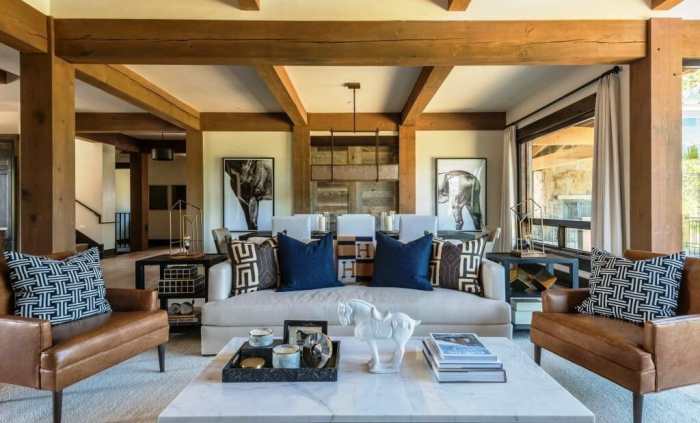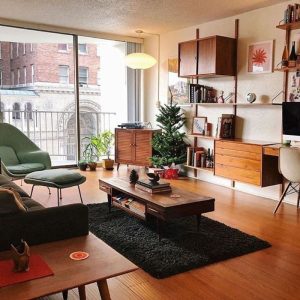
Step into a world of warmth and charm with rustic farmhouse interior design. This style embraces the beauty of natural materials, vintage finds, and a touch of country living, creating spaces that are both inviting and aesthetically pleasing. Whether you’re dreaming of a cozy living room, a functional kitchen, or a relaxing bedroom, rustic farmhouse design offers a unique blend of comfort and elegance.
This guide explores the core elements of rustic farmhouse style, from choosing the right color palettes and materials to incorporating natural elements and adding those finishing touches that truly make a space feel like home. We’ll delve into the heart of this design philosophy, providing practical tips and inspiration to help you transform your own space into a haven of rustic charm.
The Essence of Rustic Farmhouse Style
Rustic farmhouse style is a popular interior design trend that embraces the warmth and charm of a bygone era. It blends elements of traditional farmhouse design with rustic touches, creating a welcoming and inviting atmosphere. This style is characterized by its simplicity, functionality, and connection to nature.
Popular Color Palettes
The color palette of rustic farmhouse style is typically warm and earthy, reflecting the natural elements of the outdoors. Popular colors include:
- Neutral Tones: White, cream, beige, and gray serve as a calming backdrop for the bolder accents.
- Warm Accents: Shades of brown, tan, and terracotta add depth and warmth to the space.
- Natural Greens: Sage, olive, and forest green bring in the freshness of nature.
- Rustic Blues: Denim, indigo, and navy blue add a touch of sophistication.
Materials and Textures
Rustic farmhouse style utilizes a variety of natural materials and textures to create a sense of authenticity and warmth.
- Wood: Reclaimed wood, weathered barnwood, and rustic beams are commonly used for flooring, furniture, and accent walls.
- Stone: Natural stone, such as granite, slate, and limestone, adds a touch of elegance and durability.
- Metal: Blacksmith iron, copper, and brass are often incorporated in hardware, lighting fixtures, and decorative accents.
- Textiles: Linen, cotton, and wool are used for upholstery, curtains, and throw blankets.
Creating a Warm and Inviting Atmosphere

A rustic farmhouse style is all about creating a cozy and welcoming space. The goal is to make your home feel like a sanctuary, a place where you can relax and unwind after a long day. To achieve this, you’ll need to focus on creating a warm and inviting atmosphere.
Designing a Living Room Layout
The living room is the heart of your home, and it’s the perfect place to showcase the rustic farmhouse style. A well-designed layout will make your space feel larger, more inviting, and functional. When designing your living room layout, consider the following tips:
- Choose a focal point: This could be a fireplace, a large window, or a statement piece of furniture. Arrange your furniture around this focal point to create a sense of balance and flow.
- Use a rug to define the space: A large rug can help to ground the furniture and make the room feel more cohesive. Choose a rug with a natural fiber like wool or jute, and a pattern that complements the rustic farmhouse style.
- Create seating areas: Consider creating multiple seating areas within the living room, such as a conversation area and a reading nook. This will make the space more versatile and inviting.
- Don’t overcrowd the space: Leave enough space between furniture pieces to allow for easy movement. A cluttered space can feel cramped and uncomfortable.
Selecting Furniture that Complements the Rustic Farmhouse Style
The right furniture can make or break a rustic farmhouse design. When selecting furniture, look for pieces that are made from natural materials like wood, leather, and metal. Here are some tips for choosing furniture that complements the rustic farmhouse aesthetic:
- Choose distressed wood furniture: Distressed wood furniture has a timeless and rugged look that’s perfect for a rustic farmhouse home. Look for pieces with chipped paint, weathered finishes, and exposed wood grain.
- Incorporate leather accents: Leather furniture adds a touch of warmth and sophistication to a rustic farmhouse space. Consider a leather sofa, armchair, or ottoman.
- Add vintage or antique pieces: Vintage and antique furniture can add character and charm to your home.
Look for pieces with unique details and stories to tell.
- Choose furniture with simple lines: Rustic farmhouse style is all about simplicity and functionality. Choose furniture with clean lines and minimal embellishments.
Using Lighting to Enhance the Cozy Ambiance
Lighting is essential for creating a warm and inviting atmosphere in a rustic farmhouse home. You’ll want to use a combination of natural and artificial light to create a cozy and inviting ambiance.Here are some tips for using lighting to enhance the cozy ambiance of a rustic farmhouse home:
- Maximize natural light: Use large windows to bring in as much natural light as possible. Natural light is essential for creating a bright and airy space.
- Use a variety of light sources: Don’t rely on just one light source. Use a combination of overhead lights, lamps, and candles to create a warm and inviting ambiance.
- Choose warm-toned bulbs: Warm-toned bulbs emit a soft, yellow light that’s perfect for creating a cozy and inviting atmosphere.
- Use dimmers: Dimmers allow you to adjust the brightness of your lights to create the perfect ambiance for any occasion.
- Incorporate lanterns and candles: Lanterns and candles add a touch of rustic charm and create a warm and inviting atmosphere.
Embracing Natural Elements
Incorporating natural elements is a cornerstone of rustic farmhouse style, bringing warmth, authenticity, and a connection to nature into your home. These elements are not just decorative; they contribute to a sense of groundedness and tranquility, making your space feel truly inviting.
Utilizing Natural Materials
Natural materials like wood, stone, and metal play a vital role in creating a rustic farmhouse aesthetic. Each material possesses unique qualities that contribute to the overall ambiance:
- Wood: The heart of rustic farmhouse style, wood provides warmth, texture, and a sense of history. Consider using reclaimed wood for beams, flooring, furniture, or even accent walls. Its unique character adds depth and charm.
- Stone: Stone brings a sense of permanence and rugged beauty. Incorporate it in fireplaces, accent walls, countertops, or even as decorative elements. Natural stone, like granite or slate, adds a touch of elegance and sophistication.
- Metal: Metal accents, such as iron hardware, light fixtures, or decorative elements, introduce a touch of industrial chic. Metal complements wood and stone beautifully, adding a contrasting element to the design.
Bringing Life with Plants and Flowers
Plants and flowers are essential for injecting life and freshness into any space. They bring color, texture, and a touch of the outdoors inside:
- Indoor Plants: Choose hardy plants that thrive in indoor environments, like ferns, succulents, or snake plants. Place them in terracotta pots or rustic planters for a cohesive look.
- Fresh Flowers: Freshly cut flowers, in simple vases or mason jars, add a touch of vibrancy and fragrance. Consider seasonal flowers for a touch of nature’s beauty.
Creating a Focal Point
A focal point draws the eye and defines the space. In a rustic farmhouse setting, a fireplace or a statement piece of furniture often serves this purpose:
- Rustic Fireplace: A stone or brick fireplace is a classic focal point, adding warmth and character. Decorate the mantel with candles, framed artwork, or rustic décor.
- Statement Furniture: A large, antique farmhouse table or a weathered wooden dresser can become a statement piece. Place it strategically in the room to draw attention and create a focal point.
Adding Rustic Farmhouse Touches
Once you have established the foundation of your rustic farmhouse style, it’s time to add those charming details that truly bring the look to life. This is where you can let your personality shine and create a space that feels uniquely yours. Think of this stage as adding the finishing touches, the elements that create that warm and inviting atmosphere.
Incorporating Vintage and Antique Elements
Vintage and antique elements are essential for achieving that authentic rustic farmhouse feel. These pieces tell a story, adding character and history to your space. They can be anything from old farm tools and rustic furniture to vintage signs and antique lighting. Think about how these elements can be incorporated into your existing decor.
- Repurposed Furniture: Look for old wooden chairs, tables, or cabinets that you can refinish or paint to match your style. You can even find unique pieces at flea markets, antique shops, or even garage sales.
- Vintage Signs: Old signs, especially those with a farm-related theme, add a touch of whimsy and nostalgia. They can be hung on walls, placed on shelves, or even used as decorative accents on tables.
- Antique Lighting: Rustic farmhouse style often incorporates old lanterns, chandeliers, or even vintage light fixtures. These can add a touch of elegance and warmth to your space.
Using Textiles to Create a Rustic Feel
Textiles play a crucial role in establishing a rustic farmhouse ambiance. Think natural fabrics, earthy tones, and textures that evoke a sense of warmth and comfort. These textiles will add depth and dimension to your space, creating a cozy and inviting atmosphere.
- Linen: Linen is a classic choice for rustic farmhouse style, known for its durability and natural texture. Use it for curtains, tablecloths, throw pillows, and even bedding.
- Burlap: Burlap adds a touch of rustic charm with its rough texture and earthy tones. Use it for table runners, placemats, or even as a decorative element on walls.
- Cotton: Cotton is a versatile fabric that can be used for a variety of purposes in a rustic farmhouse setting. Think quilts, throws, and even rugs for a touch of warmth and comfort.
Creating a Rustic Farmhouse Table Setting
A rustic farmhouse table setting is all about simplicity and warmth. Focus on natural elements, earthy tones, and textures that create a welcoming atmosphere for your guests. Here’s how to create a beautiful and functional table setting that reflects the rustic farmhouse style.
- Tablecloth: Opt for a linen or cotton tablecloth in a natural color like cream, beige, or brown. You can also use a burlap table runner for a more rustic look.
- Tableware: Choose tableware in a rustic style, such as pottery, stoneware, or even wood. Look for pieces with a distressed or vintage look.
- Centerpiece: A simple centerpiece that incorporates natural elements, like a wooden bowl filled with fruit or a vase of wildflowers, adds a touch of rustic charm.
- Placemats and Napkins: Use linen or cotton placemats and napkins in earthy tones. You can also add a touch of rustic charm with burlap placemats or napkins.
- Accessories: Add a few rustic touches to your table setting, such as antique silverware, wooden salt and pepper shakers, or even a vintage pitcher filled with fresh flowers.
Home Improvement Considerations

When embarking on home improvement projects to enhance the rustic farmhouse aesthetic, careful planning and thoughtful execution are key. Whether it’s refreshing existing features or adding new elements, the goal is to create a space that embodies the charm and warmth of this beloved style.
Choosing the Right Paint Colors and Finishes
Selecting the appropriate paint colors and finishes is crucial for achieving the desired rustic farmhouse look. These choices play a significant role in shaping the overall ambiance and aesthetic appeal of the space.
- Opt for warm, earthy tones such as muted blues, greens, browns, and creams. These colors evoke a sense of tranquility and create a welcoming atmosphere.
- Consider using distressed paint techniques to add character and age to furniture and walls. This technique involves creating a weathered and aged appearance, which is a hallmark of rustic farmhouse style.
- For a more polished look, choose satin or semi-gloss finishes for trim and doors. These finishes provide a subtle sheen while still maintaining a natural feel.
Creating a Functional and Stylish Kitchen
The kitchen is often the heart of a home, and in a rustic farmhouse setting, it should be both functional and aesthetically pleasing.
- Embrace natural materials like wood, stone, and metal to create a warm and inviting atmosphere. A butcher block countertop paired with reclaimed wood cabinets can add a touch of rustic charm.
- Consider using open shelving to display vintage cookware and decorative items, adding a touch of character and warmth to the space.
- Incorporate a farmhouse sink, which is a signature element of this style. These sinks typically feature a deep basin and a wide apron front, adding a touch of rustic elegance.
- Add a vintage-inspired light fixture over the island or dining area, enhancing the overall aesthetic and providing functional lighting.
Creating a rustic farmhouse interior is about more than just aesthetics; it’s about crafting a space that reflects your personality and evokes a sense of warmth and comfort. By embracing the principles of this timeless style, you can create a home that feels welcoming, inviting, and truly your own. From the cozy corners to the carefully curated details, every element contributes to a space that exudes warmth, authenticity, and a touch of rustic charm.
Key Questions Answered
What are some common mistakes to avoid when designing a rustic farmhouse interior?
Overdoing it with rustic elements can lead to a cluttered or overwhelming space. Avoid using too many different patterns or textures, and focus on creating a cohesive and balanced look.
How can I incorporate modern elements into a rustic farmhouse design?
Modern touches can be incorporated subtly through sleek furniture pieces, geometric patterns, or contemporary lighting fixtures. The key is to balance these elements with the rustic charm of the space.
What are some budget-friendly ways to achieve a rustic farmhouse look?
Shop for vintage and antique pieces at flea markets and thrift stores. DIY projects, such as repurposing old furniture or creating your own farmhouse-style signs, can also add a personal touch and save money.







